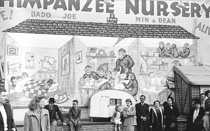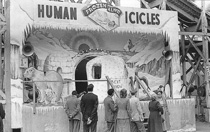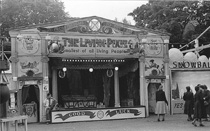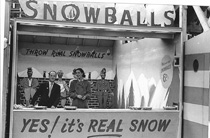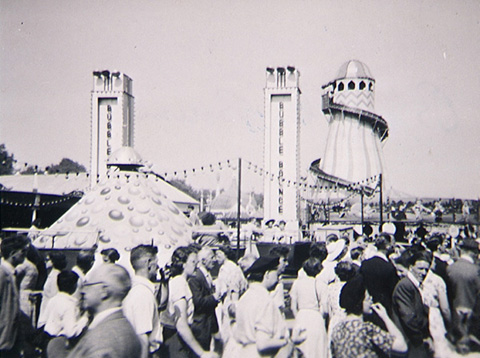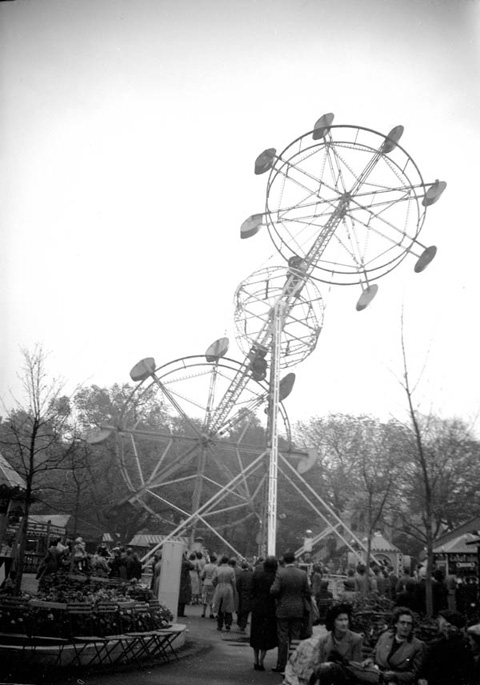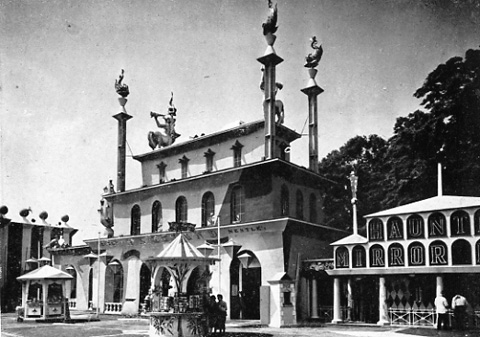|
|
|||||||||||||
| HOME ARTICLES GALLERIES ABOUT US FORUM LINKS CONTACT JOYLAND BOOKS | |||||||||||||
|
BATTERSEA FESTIVAL GARDENS 1951 (PAGE 5 OF 5) by Phil Gould Article: Added May 2011 |
|||||||||||||
|
Close by these two attractions were the other novelties imported for the Festival Gardens. Alf Makin supplied the Hurricane. This had a central tower which had six arms connected to four seater cars. The ride picked up speed and centrifugal force pushed the cars to a horizontal plane. Then a solenoid was employed causing them to dip back down before flying back to the horizontal once more. This ride was similar to a ride called the Ramba Zamba that was travelled by Shaws in the 80s. In the same decade a couple of modern versions of the Hurricane were imported into the UK and operated by Pat Evans at Porthcawl and M & D Taylor. The latter ride putting in an appearance at Hull Fair. Belle Vue Amusements were responsible for the next novelty the Bubble Bounce, built by US company Hrubetz. Ten individual tubs, which could be spun by riders, were positioned on a spinning platform. As the ride built up speed the platform was forced up at a 20 degree angle then lowered again, giving the motion of bouncing. On some models at the end of the ride the air was expelled from the pistons allowing the ride to land on a inflated platform and bounce. I’m not sure if this ride had the latter feature. After a few years this ride was transferred to Belle Vue. It might even still travel in the North West today with the Chadwick family . But the bouncing motion has not operated for many years. The Jets ride had been built by the Eyerly Aircraft Company of Oregon and was operated by Moorhouses of Southend. Eight arms had two seater planes at the end. As the ride gathered speed the arms would be raised into the air and riders could perform stunts including rollovers. However, the unlucky ones would spend the entire ride hanging upside down! This ride spent many years at the Kursaal in Southend. You can still see this ride today as, following extensive refurbishment, it is travelled around Berkshire by independent showmen Masons. Other attractions housed in permanent buildings included the Haunted Mirror Maze, the Fun House and the Nestle Playland (a crèche and children’s playground). These three attractions were positioned at the front of the amusement park. Also probably worthy of a mention was the park’s miniature railway. This was called the Far Tottering and Oyster Creek Railway. Three locomotives - Nellie, Neptune and Wild Goose - pulled four coaches seating 96 passengers. The rolling stock and stations had been styled to designs by Punch cartoonist Rowland Emett. This was the complete list of attractions on the opening day, although it has to be said not all of the rides were operational from day one. During the summer some standard British funfair rides were introduced to fill in gaps at the park. These included George Whittingham’s Lakin-built Ark Speedway, Albert Botton’s Ghost Train, B Styles Big Wheel - sited inside the Big Dipper and a second Lighthouse Slip from Bottons. But this final ride only stayed a few weeks and was removed to make way for the final novelty at the Festival Gardens. In the second week of September the long-awaited Sky Wheels arrived. Built by Samuel Butler of Leeds for Iles of Belle Vue this late arrival certainly made an impression. It had two 26ft big wheel style wheels which each had eight two seater cars. These were attached to either end of a centrally pivoted boom. As this revolved the two wheels turned in the same direction. Even though this proved to be a great talking point this ride only survived two seasons before being bought by Blackpool Pleasure Beach.
The Amusement Park was only supposed to operate for six months but was such a success that it reopened for business the following year. At the end of the 1953 season a private company took over the operation of the park and it survived until 1974. If you walk through Battersea Park today it is hard to imagine where all the thrills and spills of the amusements were once built in this now leafy municipal park. But for many people the Festival Gardens has left a lasting legacy and is seen as the forerunner of this country’s theme parks. |
 Alf Makin's Hurricane in full swing. Picture: Horst Koch
|
||||||||||||
|
|||||||||||||
|
|
|||||||||||||
|
THEMAGICEYE | Terms and Conditions | Privacy Policy | Contact Us |
|||||||||||||

